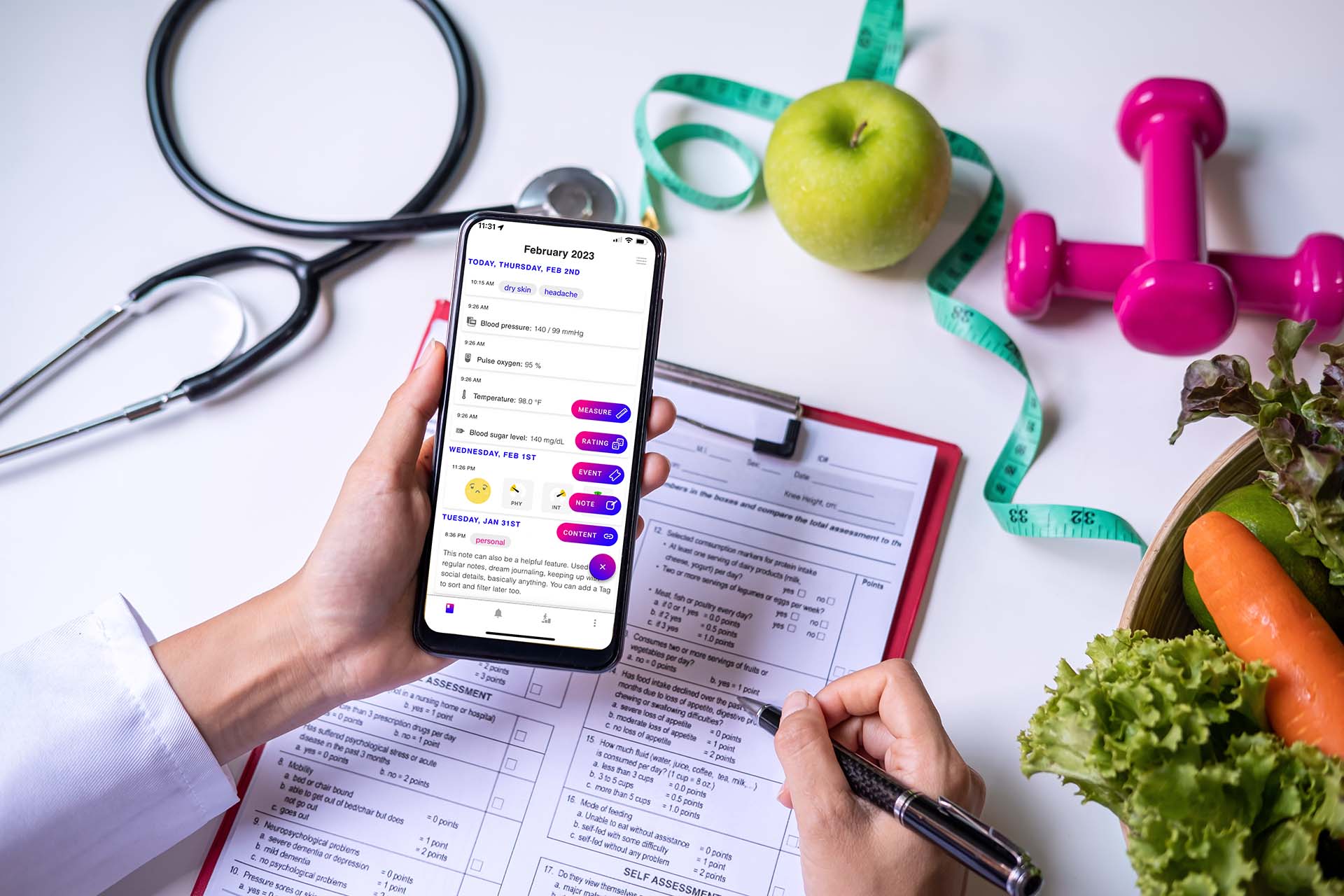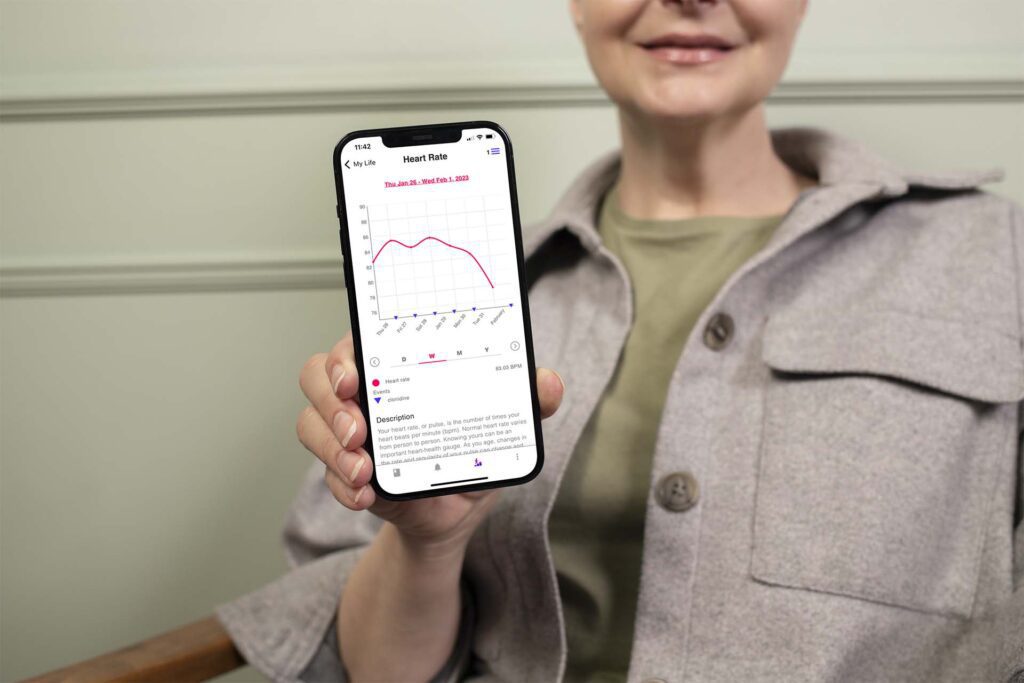Healthcare providers struggle with organizing patient information during visits.
A symptom diary or patient log returns autonomy to the patient in managing their health outcomes. This empowers them to make better decisions and provides healthcare professionals with more informative data.
This is not about Electronic Health Records (EHR) software, which poses its own unique problems. Though convenient and helpful in some instances, EHR software tools have limits. They’re used primarily in a medical office environment and have severe limits regarding scalability, compatibility, cost, training, security, and usability.
Another limitation of most EHR software is that patients often cannot leverage it to return helpful information to their healthcare provider. This can certainly be addressed with today’s distribution and access to technology.
The patient encounter can provide a lot of information.
So what happens during a patient encounter or an appointment? A patient will list off many symptoms, varying timelines, complaints, and emergency department visits, all sorts of things. There is a limited amount of time a healthcare provider can spend with each patient during a visit. This poses a communication problem that often leads to misdiagnoses and dissatisfied patients.
Making sense of the disorganized details of the patient’s history is often hindered by the limited time allowed in appointments and the patient’s lack of insight, unreliable recall, and emotional state of mind.
Yet, what if a patient could pilot their personal record-keeping? As a healthcare provider, you could receive accurate information organized in a consumable manner and supplemented by smart technology like health and fitness trackers.
To help improve information-gathering during an appointment, symptom diaries may be used as a strategy.
What is a symptom diary?
A symptom diary, or patient log, is a written record of the symptoms that a person is experiencing over some time. It can track changes in symptoms, provide information to healthcare professionals, and help people better understand their condition. It may include details on when the symptoms first appeared, how often they occur, what makes them worse or better, and any other factors that may be relevant.
Key features of a symptom diary include symptom timing, duration, associated symptoms, triggers, alleviating factors, and lifestyle considerations.

A symptom diary or patient log like Best Life Health Diary can record variables like symptoms, timing, duration, associated symptoms, triggers, treatments, medications, and more. This information is incredibly helpful for healthcare providers and increases the quality of care patients that use a symptom diary will receive.
There are benefits for providers and patients when using a symptom diary.
Symptom diaries offer several benefits. Whether using a paper symptom diary or an electronic version, like the Best Life Health Diary, there are many reasons to consider switching from standard interview-style appointments to diary-based discussions.
Patients engage more and are provided peace of mind.
Keeping a symptom diary gives the patient a sense of control and direct involvement in the treatment plan. For some patients, writing out their symptoms, experience, and emotions also provides a therapeutic behavioral benefit.
Knowing that you are keeping track of your symptoms can provide peace of mind for patients. You can rest assured that you are actively managing your health and have the information you need to make informed decisions about your care.
Preparation saves time and alleviates the chance of misunderstandings.
The amount of time it takes a physician to review a one-page diary is substantially less than it takes to interview a patient for the information verbally. A symptom diary can also organize the patient’s history for more meaningful clinical interpretation.
Trigger identification becomes more achievable.
A diary can help the physician identify nuances of symptoms within a disease process and can directly lead to activity modification and lifestyle changes that optimize overall function.
For patients, this can help identify patterns and triggers associated with symptoms. A symptom diary can help patients and their doctors identify patterns or potential triggers associated with symptoms. Tracking symptoms over time can provide valuable insight into when and why the symptoms occur.
Data visualizations and visual assessments increase comprehension for both providers and patients.
Visual learners can quickly scan the document and digest the information. Especially when combined with other data sources, like environmental data for barometric pressure, pollen, temperature, weather, and other details, this data visualization and lead to unforeseen insights and potential solutions for patients and providers.
Best Life Health Diary specifically allows patients and physicians to see variables over time, like heart rate, and overlay treatments and medications. This powerful data visualization demonstrates the effectiveness of medication for this unique individual.

Opportunities to save money (and stress) arise.
Symptom diaries can create a more thorough history, potentially limiting unnecessary laboratory and radiographic testing. This reduces the time it takes for a patient to reach a higher quality of life and improved health. This also reduces a patient’s stress while attempting to schedule, pay for, and manage procedural needs.
Uses for a symptom diary can be found in primary care settings.
Headache diary
A headache diary can be an invaluable tool for the patient and the clinician. It can help identify the type of headache, assess potential triggers, develop a treatment plan, track the effectiveness of treatments, and detect any severe complications. By engaging the patient in tracking their symptoms, they are more likely to avoid triggers and gain better control of their condition. Additionally, reviewing past diaries alongside current ones can help demonstrate progress to the patient.
Ultimately, the information gathered from a headache diary can assist a clinician in making informed decisions about treatment changes.
Food diary
Food diaries are an effective tool in helping patients to become more aware of their dietary habits and make positive lifestyle changes. Even something as simple as recording the food consumed on a calendar or taking a picture of one’s plate with a mobile device can be beneficial.
Studies have demonstrated that those seeking weight loss while tracking food intake achieved double the impact than their peers who did not track food intake during the same period of time.
Exercise diary
Exercise diaries are an invaluable tool for those looking to make a lifestyle change. Keeping track of goals, progress, and obstacles in an exercise diary can help patients stay accountable and motivated. It also allows them to increase the intensity of their workouts, document improvements safely, and set realistic expectations.
An exercise diary ultimately helps individuals stay on track with their fitness journey, despite setbacks, such as a busy schedule or bad weather.
Voiding diary
Voiding diaries can help diagnose various conditions, such as lower urinary tract symptoms, benign prostatic hypertrophy, interstitial cystitis, incontinence, and urinary frequency. The diary should include information on leak episodes and volumes to evaluate incontinence properly. The diary length can vary from 24 hours to two weeks, depending on the purpose of the evaluation. Additionally, the timing of voids concerning oral intake can be used to pinpoint when symptoms are especially problematic and help the physician address behavioral aspects of management. Finally, the diary can create a baseline for monitoring the effects of bladder drills, retraining, and therapeutic interventions.
This type of tracking can also assist those managing Irritable Bowel Syndrome (IBS) and Crohn’s Colitis for the same reasons.
Sleep diary
Sleep diaries can be a beneficial tool in diagnosing various sleep disorders, including insomnia, obstructive sleep apnea, restless leg syndrome, and circadian sleep disorders. Without a sleep diary, it is difficult to get the necessary quantitative and qualitative information to assess a patient’s sleep patterns accurately and efficiently. Furthermore, patients may only remember extremes and be vague in their descriptions. This could be because they recall their worst nights of sleep more easily. Additionally, sleep diaries can serve as a therapeutic resource for patients to recognize their sleep patterns and identify any factors contributing to their disrupted sleep.
Finally, sleep diaries can also aid in implementing sleep hygiene interventions, such as going to bed at the same time each day or avoiding naps, which may lead to significant symptom relief.
Bonus perk, a sleep diary can double as a dream journal and help just as much with mental health as with physical health.
General symptom diary
A symptom diary can be a handy tool for patients experiencing vague somatic complaints such as general pain syndromes, irritable bowel syndrome, fatigue, gastrointestinal disorders, menstrual irregularities, cardiac symptoms, or neurologic complaints. It can help to provide an objective trend that can help to solidify an underlying diagnosis or syndrome. Furthermore, presenting this information concisely allows for more focus on the patient and validates their complaints, strengthening the therapeutic relationship. Additionally, the diary can help visualize the illness’s course and promote patient resiliency.
Symptom diaries can be beneficial for managing various other medical conditions, including endometriosis, heart failure, asthma, chronic pain, chronic obstructive pulmonary disorder (COPD), heartburn, hypertension, blood glucose disorders, breastfeeding difficulties, and menstrual irregularities.
Symptom diaries are a low-cost, low-risk solution to a widespread communication problem.
A symptom diary is a practical and cost-effective way for healthcare providers to assess their patients better. By providing patients with an organized format for tracking their symptoms or activities, physicians can gain more insight into their patient’s condition without needing costly tests, procedures, or medications. Even simple paper-based diaries have the potential to provide immense benefits to both patient and provider.
With further professional interest and support, symptom diaries could become even more widely accepted and utilized in the outpatient setting.
Sources
The Use of Symptom Diaries in Outpatient Care
Mobile apps for mood tracking: an analysis of features and user reviews
Weight loss during the intensive intervention phase of the weight-loss maintenance trial
Effect of a symptom diary on symptom frequency and intensity in healthy subjects
Who we are
The Live Learn Innovate Foundation is a 501(c)3 nonprofit entity that empowers software users to regain control of their personally generated health data, gain intuitive insights about their social data, learn the impact of their environment on health, and build a foundation of data analytics that empowers research, academics, and innovation in economic development.
Use cases for this secure, private data aggregation method appear everywhere, expanding to family care, community growth, agricultural planning, and many more things still unseen. Help us keep going by getting involved today.
7 Responses